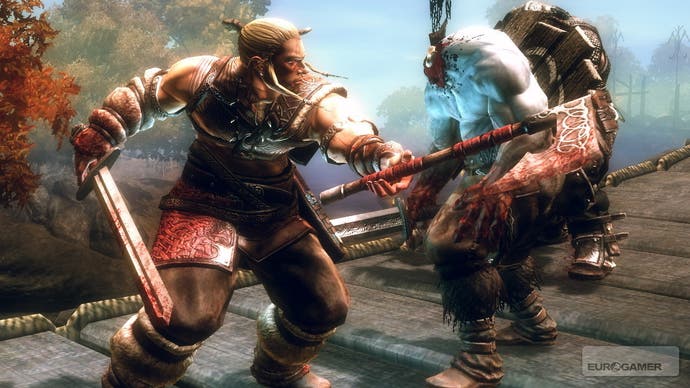Viking: Battle For Asgard
Helish.
Opening up gaming to the masses is one hell of a double-edged sword. Sure, make games more approachable, with intuitive controls and a steady learning curve. By all means introduce rechargeable health systems and automatically save progress as you go along. Hell, respawn the player into the action if it's feasible in the context of the storyline. Some of our favourite games of recent times have managed all of the above without making us cry. But Viking? It makes us want to swing sharp implements of death around with scant regard.
It takes accessibility to a ludicrous, self-defeating extreme, where playing the game on its hardest difficulty level still allows you to beat most of the enemies simply by stabbing a single button in anger. After a few hours of doing the exact same thing over and over, you'd prefer that the stabbing and anger were directed at the normally reliable Creative Assembly. Instead of lending its strategic prowess to the increasingly crowded hackandslash genre, any semblance of tactical nous is thrown out of the window quicker than you can dismember one of the game's many clueless drones.
It all starts off promisingly enough, with a reasonably engaging yarn with Brian Blessed's excellent contribution ensuring that you won't skip every cut-scene. For the record, it centres around a tussle for Asgard, the realm of the Norse Gods, with goddess Hel none-too-happy about being kicked out for defying Odin. Essentially, the battle has spilled over into the mortal world of Midgard, and Freya, the goddess of love and war, takes it upon herself to make young warrior Skarin her champion. Blessed with immortality, he must save the future of mankind, blah.

Without further ado, you're off trudging around hugely detailed rustic environments, chatting to locals and getting your bearings. Looking for all the world like a Fable-esque re-imagining of Gears of War, there's no denying that Creative Assembly has conjured up a hugely atmospheric, extremely detailed and frequently gorgeous game world, packed with incidental action and vibrant ambience - not to mention rendering insane numbers of characters on screen at once. When it gets into its stride, there's a sense of chaotic battle better than almost any other, as scenes are packed with delicious violence. Gloriously vicious slow-motion dismemberment and buckets of claret are standard-issue throughout, and, given the excellent animation, you can't help but admire the carnage. If that's possible.
Equally encouraging is the openworld approach, which draws initial comparisons with Crackdown for the way it allows players to pick and choose which area you want to liberate next, and how you fancy going about your assault (full frontal or sneak in around the side, for example). With most of the map open to you from the word go, you simply charge off in whatever direction you want, stumble across a village in peril and set about chopping up everyone in sight. If you die, the fact that you're immortal gives you an excuse to simply respawn at one of the nearby Leystones, which are basically portals which also allow you to traverse the island quickly. Once the coast is clear, you free the captives, mop up any stragglers and move on to another point of interest.

The whole point of liberating each area is to ultimately persuade all the various clans to get behind you for a climactic assault on the map's stronghold. Getting them onside, though, isn't simply a case of freeing them from captivity, but almost always also involves fetch-quests before they'll commit to helping you out. Ungrateful sods that they are, they'll demand you toddle off and find their grindstones and whatnot, which is just one of many ways the game appears to delight in wasting your time.
Fetch-quests we can handle now and then. They help change the pace a little, and give the game a chance to build up the narrative and encourage interaction with the cast. What we can't forgive so easily is how depressingly mundane the combat is, and how little it actually progresses from the early encounters. On the surface, Viking apes the industry-standard light/heavy attack combo system favoured in every game from Onimusha onwards, through Devil May Cry, Ninja Gaiden, God of War and Genji. Scratching the surface, you'll note how few attack combos there really are, and how much success you get from merely mashing the heavy attack button.



